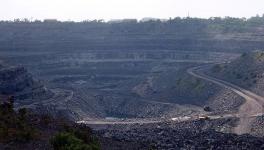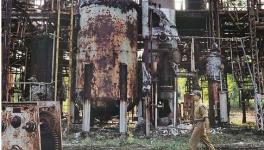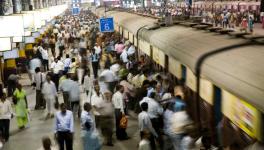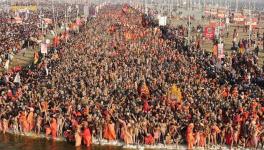Should Faith be Used to Brush Away Filth?
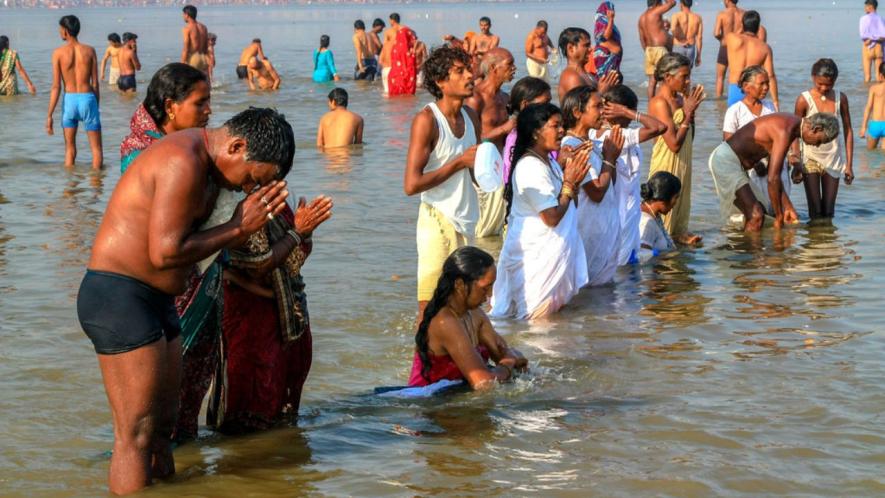
Representational Image. Image Courtesy: Flickr
Faith and filth have an uncanny existence together
The latest in series happens to be the report by the Central Pollution Control Board (CPCB) underlining how they have found high faecal bacteria levels in Prayagraj river water, which fails bathing standards and the summoning of the Uttar Pradesh PCB (UPPCB) authorities by National Green Tribunal (NGT) over non-compliance of directives regarding 'serious water quality violation in Ganga, Yamuna at Prayagraj'
The fact is that NGT has repeated itself when it said that high levels of faecal and total coliform were found at various locations at the Maha Kumbh, during a hearing on allegations that untreated sewage has been discharged into Rivers Ganga and Yamuna in Prayagraj.
Will the UP Chief Minister Yogi Adityanath's rejection of this report on the floor of the House and underlining that the water at the Sangam was fit for 'drinking' serve any purpose when NGT grills the UPPCB authorities over non-compliance of their directives issued earlier over the quality of water?
Any sane person would know the answer.
May be in a bid to appear uncompromising or cover his own nervousness over the developments, Adityanath tried to question the veracity of this report - in an indirect way - by condemning people who spread misinformation against “Sanatan Dharma, Maa Ganga, and India" and warning them that they were attacking the “faith of those 56 crore people who had taken a bath there.”
True, that none of the strongest critics of the ruling dispensation would have imagined that as the Mahakumbh Mela concludes in the next few days, the lasting image would not be Yogi Adityanath getting accolades for organising this 'historic mela' but the reprimand received by UPPCB over the presence of high levels of faecal coliform bacteria, which mainly come from human and animal faeces, indicating that the water people used for bathing contaminated with sewage, leading to the potential spread of waterborne diseases such as typhoid, diarrhoea, and cholera.
The detailed critique presented by CPCB about the quality of water arising from sewage treatment plants installed at Prayagraj (earlier known as Allahabad) unable to treat the complete sewage received by them and untreated sewage flowing directly into the water or massive open defecation practiced by the pilgrims around the mela site for want of commensurate arrangements, would be difficult to brush aside.
Looking at the fact that the report is prepared by CPCB and further debated by NGT -- both working under the Central government led by the present Numero Uno of the ruling dispensation -- it will be difficult for the UP Chief Minister to categorise these hard-hitting exposes, which bring forth the massive gap between the claims of safe and secure bathing at Sangam and the actual situation on the ground, as part of ecosystem engaged in 'degrading Sanatan.'
Questions will be raised more forcefully and the examinee will have no option to declare unilaterally that these 'are out of syllabus'.
What is worth emphasising here is that the reprimand delivered by NGT to UPPCB, inadvertently or so, also exposes the vacuousness of the Central government and its representatives who had made bold claims about making strenuous efforts to “maintain the hygiene of the river waters” supposedly based on the technology contributed by India's nuclear research centres. (
It may be recalled here that Union Minister for Science and Technology, Jitendra Singh, had told reporters at Prayagraj, when he had come to take a bath at Sangam, about how the Bhabha Atomic Research Centre in Mumbai and the Indira Gandhi Centre for Atomic Research in Kalpakkam had set up wastewater filtration plants in Prayagraj.
Remember that allegations of mismanagement of the Mela have been raised from time to time.
Right from various reports about tents catching fire at the mela site, which did not get the attention they deserved, to huge traffic jams - some few hundred kilometres long - on way to Allahabad, accompanied by the tragedy of stampede on Mauni Amavasya, which officially put the number of dead at 30 and wounded at 80. Also remember that the casualty figure was acknowledged after 17 hours of the incident, with allegations of more deaths still refusing to die down.
Till date, it has been possible for the UP government to silence critics or forcing truth-seekers to keep quiet, basically by invoking the narrative of “insult to Sanatan Dharma.” But, now, it will be increasingly difficult for the state government to offer any self-defence when a section of conscious people speak up on how they were made to bathe in polluted water. Convincing them with official denials about the quality of water will not work.
Coming back to the NGT’s observations and its claim that the degree of pollution was found to be maximum at the Sangam and the water used by people was not fit for bathing as it was mixed with sewage water, the facts on the ground would be difficult to brush aside.
Four broad queries demand clear cut answers from the powers that be, with no dilly-dallying:
One, why did UPPCB not put in extra efforts to put in place mechanisms/arrangements before the Mela started, knowing full well that millions of people would be flooding the area?
Two, why could it not ensure that the sewage treatment plants installed there remained fully functional so that no sewage could be flown directly into the river?
Three, why did it not make urgent efforts to ameliorate the situation when the CPCB submitted its finding to UPPCB so that millions of devotees could be saved from bathing in 'sewage water'?
Four, if it discovered that the task set before itself was impossible to achieve, why did it not press the emergency button, communicate to the ruling dispensation to discourage people from coming to the Kumbh, so that they be saved from bathing in dirty water mixed with faecal content?
Everybody knows that formally the queries may be addressed to UPPCB, which is handled by personnel in the state bureaucracy, but the ultimate responsibility of the arrangements falls on the shoulders of the Chief Minister and his colleagues, and also the ruling dispensation at the Centre.
Can they suddenly deny their ultimate responsibility when the state government and the Central government joined hands for this 'historic Mahakumbh' and invited people from all over India to the 'once in lifetime opportunity' which was “happening after 144 years”?
Can they deny the fact that over Rs 7,300 crore were given to the Mela organisers to ensure a safe and secure gathering of people keen to take a bath during 'auspicious period'?
Perhaps a financial audit of the expenses would also be needed to verify why it could not be ensured that at least the sewage treatment plants remained fully functional or why arrangements were not made to install some extra plants looking at the humongous crowd?
It is possible that cheerleaders of the ruling dispensation at the Centre and also in UP would argue that the unprecedented crowds coming from different parts of India caused all the preparations to go haywire.
This is a very weak argument, more so when the world has seen the massive advertisement campaign unleashed by the ruling dispensation, jointly carrying the photographs of Prime Minister Narendra Modi as well as Chief Minister Yogi Adityanath. Without such an advertisement campaign, millions of people gather for the Kumbh Mela. But, when the government itself pushed it further, it was expected that massive crowds would throng the site, which demanded a high level of reparations.
Remember, if there is a mishap at any gathering, the main responsibility falls on the shoulders of the organiser/s – those who have/have sent invitations. The same is the case of this 'historic Maha Kumbh'.
It was the responsibility of the main organisers to have looked at earlier experiences of mass gatherings for religious baths and drawn necessary lessons.
Numerous studies are available in the public domain that bring forth this 'paradox of purification'
“Millions descend upon the ghats during the Kumbh Mela, seeking spiritual cleansing through ritual bathing (snan) in the sacred rivers. While this act holds immense significance, it creates a paradoxical situation for the very waters they revere. The sheer volume of people releases a significant amount of fecal coli form bacteria and other pollutants. Offerings like flowers, puja materials, and even soap meant to be acts of devotion contribute to organic and inorganic pollution. This can lead to a decline in dissolved oxygen levels, harming the aquatic life that thrives within these rivers, considered sacred forms of life themselves. Essentially, the very act of seeking purification in the river can unintentionally diminish its ability to purify.”
In fact, they could have looked at the experience of the last Ardh Kumbh held at Allahabad/Prayagraj in 2019 and would have realised that there was a quantum jump in the faecal coliform content that comes from human excreta:
CPCB guidelines say if the fecal coliform content, which comes from human excreta, is more than 2,500 million per 100 ml, it is unfit for bathing. At Sangam Ghat, the fecal coliform content in February was 12,500 millions per 100 ml water, shows UPPCB data. At Shastri Bridge, it was 10,150 millions per 100 ml.
Obviously, during Kumbh the Ganga was unfit for drinking as well. Startling figures of total coliform, which comes from sources such as environment, soil, water confirm this. CPCB guidelines say Ganga water should never be consumed directly.
Or, earlier studies of similar gatherings:
Scientists, who conducted a study at five locations across Godavari river, say open defecation by pilgrims and bad sewage management and waste disposal system are the major contributors
Undoubtedly, questions raised by NGT regarding the quality of water at the Mahakumbh and how people were allowed to gather without adequate preparations will not die away soon.
More and more people will realise that the 'sacred bath' they had at the Sangam during the 'auspicious period' was laced with 'sewage water'.
A section of pilgrims would also gather courage to raise the question of how their faith was exploited by the powers that be for their short-term aim to project themselves as ‘Hindu Hriday Samrats’.
The writer is an independent journalist. The views are personal.
Get the latest reports & analysis with people's perspective on Protests, movements & deep analytical videos, discussions of the current affairs in your Telegram app. Subscribe to NewsClick's Telegram channel & get Real-Time updates on stories, as they get published on our website.













